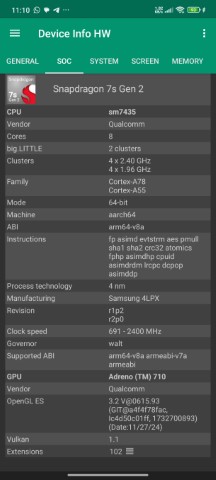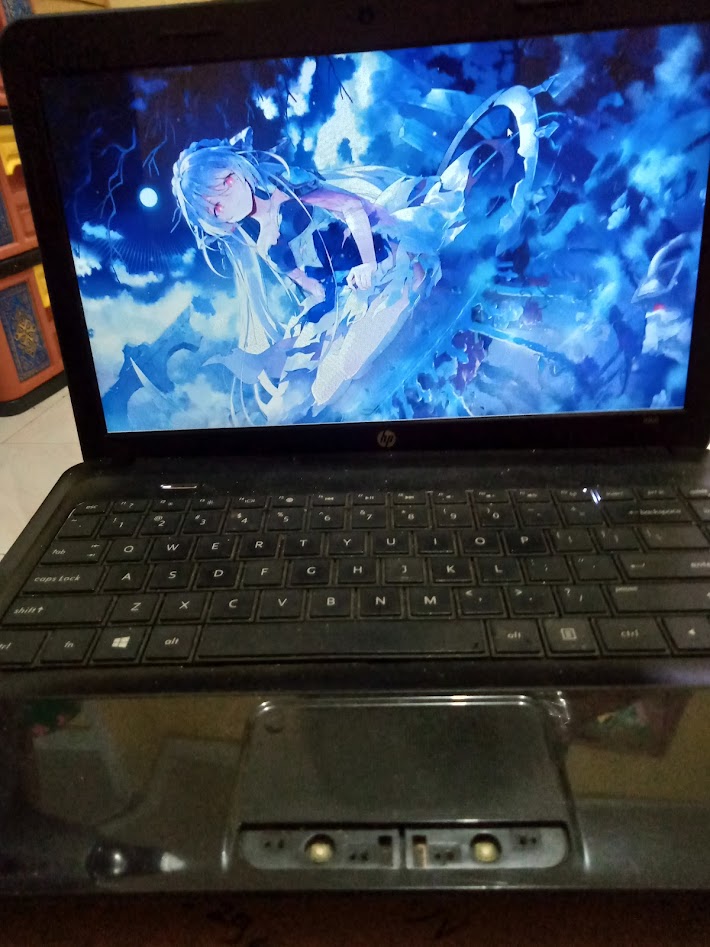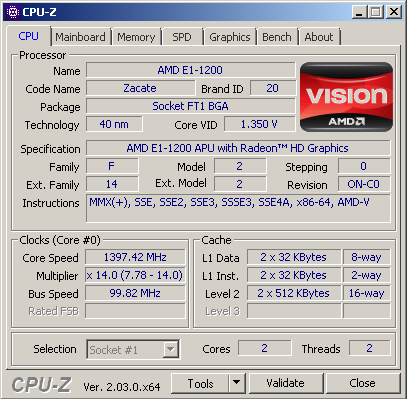Comparing: AMD E1-1200 vs Qualcomm SM7435-AB Snapdragon 7s Gen 2
In this comparison, we analyze two Processors: AMD E1-1200 and Qualcomm SM7435-AB Snapdragon 7s Gen 2, using synthetic benchmark tests to evaluate their overall performance. This side-by-side comparison helps users understand which hardware delivers better value, speed, and efficiency based on standardized testing. Whether you're building a new system or upgrading an existing one, this benchmark-driven evaluation offers valuable insights to guide your decision.

Qualcomm SM7435-AB Snapdragon 7s Gen 2
| Type: | Processors |
|---|---|
| Brand: | Qualcomm |
| Model: | Snapdragon 7s Gen 2 |
Specification Comparison Table
This specification comparison presents technical details of several devices or components to help you understand the key differences between each option. Use this table as a reference to determine which device best suits your needs.
| Specification | AMD E1-1200 | Qualcomm SM7435-AB Snapdragon 7s Gen 2 |
|---|---|---|
| Architecture | x86 | ARM |
| Technology | 40 nm | 4 nm |
| Clock | 1.4 GHz - - | 1.9 GHz - 2.4 GHz |
| Core/Thread | 2 / 2 | 8 / 8 |
| Segmen | Mobile | Mobile |
Submission Comparison Table
This submission comparison table displays the number and details of benchmark data submissions from various devices or components. This information helps you understand the performance based on the benchmarks that have been tested, as well as providing an overview of the consistency and popularity of the available benchmark results.
| No. | Benchmark Software | AMD E1-1200 | Qualcomm SM7435-AB Snapdragon 7s Gen 2 |
|---|---|---|---|
| 1 | Geekbench6 - Multi Core |
193 points |
2916 points |
| 2 | Geekbench6 - Single Core |
107 points |
1026 points |
Submission Comparison Chart
This chart visualizes the benchmark scores comparison between two hardware devices based on submitted data.
Media Gallery
A collection of photos of tested hardware. These images can help you identify the physical form, model, and variant of the hardware in question. These photos are from our own documentation, and if they are not available we may not be able to document them.
About Hardware AMD E1-1200
Released in 2012 as part of the Brazos 2.0 family, the AMD E1-1200 is a power-efficient processor aimed at entry-level laptops. It has a 2 core and 2 thread configuration with a fixed clock speed of 1.4 GHz, with no support for Turbo Core technology. Built with a 40nm fabrication process, the E1-1200 has a TDP value of 18 watts-efficient enough for portable devices that emphasize low power consumption and longer battery life. Despite its limited performance, the E1-1200 was a popular choice in its day thanks to its affordable price and ability to handle light computing needs.
One of the main advantages of the AMD E1-1200 is the integrated Radeon HD 7310 GPU, which offers better graphics performance than Intel's entry-level graphics solutions at the time. This GPU has the ability to play HD resolution videos smoothly, as well as run light games such as Counter Strike 1.6, Plants vs Zombies, or other casual games with minimum graphics settings. That said, this combination of CPU and GPU is not intended for heavy-duty work such as video editing, 3D rendering, or modern gaming. Overall performance is more optimal when used for tasks such as browsing, streaming videos, accessing social media, typing documents, as well as basic office applications.
However, it should be noted that the AMD E1-1200 is less suitable for heavy multitasking, especially in modern operating systems like Windows 10. With a low clock speed and no Boost feature, users may experience lag or limitations when opening multiple applications at once. In tests using the HP 1000 1b05au laptop, this processor was paired with 4GB DDR3 single channel RAM (2 DIMM slots) and tested on Windows 7, Windows 8, and Windows 10 operating systems. The results show that the most optimal performance is achieved on Windows 7 or Windows 8, while in Windows 10 the system tends to be slow although it can still be used for basic needs. As such, the AMD E1-1200 can still be relied upon as a power-efficient and inexpensive solution for users with very light computing needs.
Hardware Detail:
Device: HP 1000 1b05au
RAM: 4GB DDR3 Single Channel 2 DIMM
OS: Windows 7, Windows 8, Windows 10
Wednesday, 26 December 2012 14:27:36 | Update: 1 month ago
About Hardware Qualcomm SM7435-AB Snapdragon 7s Gen 2
The Qualcomm Snapdragon 7s Gen 2 (SM7435-AB) is one of the latest System on Chip (SoC) solutions designed to deliver high performance in the mid-range segment without compromising on energy efficiency. Built using advanced 4nm fabrication technology, this chip offers an ideal balance between processing power, energy efficiency, and robust graphics capabilities. The Snapdragon 7s Gen 2 features an octa-core CPU configuration (8 cores/8 threads) operating at clock speeds ranging from 1.9GHz to 2.4GHz, enabling it to handle a variety of computational tasks, from light multitasking to casual gaming.
While details such as L3 cache and the official codename have not been widely disclosed, the chipset's performance is evident from benchmark results. In testing using the Xiaomi Redmi Note 13 Pro 5G running Xiaomi HyperOS 1 based on Android 14, the Snapdragon 7s Gen 2 achieved competitive scores in its class. In the AnTuTu v10 benchmark app, the CPU score reached 200,590 points, positioning it as one of the top choices in the mid-range segment. Meanwhile, in the Geekbench 6 synthetic performance test, the chipset achieved a score of 1,026 for single-core and 2,916 for multi-core, proving that this SoC can handle various modern applications smoothly.
For graphics, the Snapdragon 7s Gen 2 relies on the integrated Qualcomm Adreno 710 GPU, which is sufficiently capable for playing popular games at medium to high graphics settings. The chipset also uses a BGA (Ball Grid Array) socket design, a common standard for modern mobile devices, ensuring dense and efficient integration.
The test device uses 256GB UFS internal storage and 8GB RAM, ensuring no memory bottlenecks during benchmarking. All testing was conducted on a brand-new device, using the latest operating system and benchmarking applications, and after all system updates were applied.
Overall, the Snapdragon 7s Gen 2 is an excellent choice for users seeking a balance of performance, efficiency, and reliability in a mid-range device. With solid benchmark results and 4nm fabrication technology, this chipset is one of the most competitive options in the current 5G smartphone market.
Device Test (testbed):
Device: Xiaomi Redmi Note 13 Pro 5G
Specs: Snapdragon 7s Gen 2, 256GB UFS, 8GB RAM
OS: Xiaomi HyperOS 1 (Android 14)
* Testing device in new condition, latest benchmark software, and latest system updates
Wednesday, 09 July 2025 23:12:14 | Update: 6 days ago




